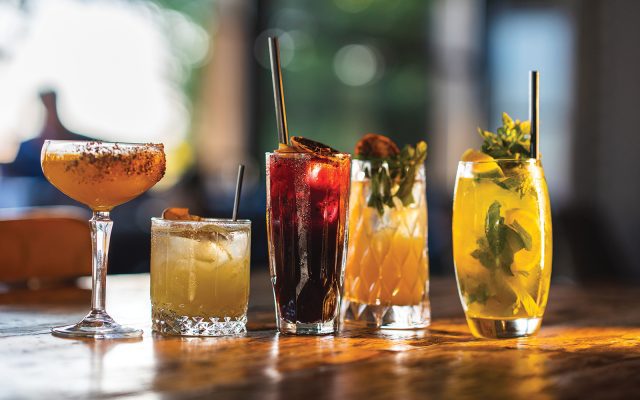Is it time for ABVs on cocktail menus?
By Lauren BowesAs consumers become more aware of what they’re drinking, how can bars help provide information about alcohol content?

*This feature was originally published in the March 2024 issue of The Spirits Business magazine.
For many bartenders, making the perfect cocktail means considering ingredients, technique, and glassware; it’s a feat of creativity, using a significant amount of science, but barely any maths.
Costing a cocktail menu is one of the less fun parts of the job – so how would you feel about adding an extra calculation into the equation?
In the ever-growing world of no-and-low drinks, consumers are becoming more conscious of what they’re drinking. According to data from IWSR Drinks Market Analysis, the percentage of people who drink no-and-low products alongside alcoholic drinks is rising, while the number of those abstaining completely is falling. Drinkers want to be more informed about what and how much they’re consuming, so it could be time to consider adding ABV levels or alcohol units to menus.
Bobby Hiddleston, the co-founder of Swift cocktail bars in London, says he’s never considered adding ABVs to his menus.
“That is primarily to keep the menus as simple and clean as possible,” he explains. In a world where restaurants and bars often stylistically leave currency symbols off prices and add service charges and charity donations to final bills, would an extra number on a menu simply be ignored – or, worse, misunderstood – by guests?
There’s also another number on menus that UK guests have had to face in recent years – from 2022, businesses with more than 250 employees have had to display calorie information for food and soft drinks on menus. Research from customer experience platform Feed It Back found 41% of diners said they were likely to change their dish to something with fewer calories when this information is listed, while 48% were indifferent to them.
If ABVs were listed on cocktail menus, certain guests would likely change their drink choice when armed with the information, says Hiddleston. “Adding it would likely mean that guests would drink less, which is great for responsibility but ultimately not great for business, so it’s a double-edged sword,” he explains.
But there is also a chance that guests would change their drink for the opposite reason, instead choosing the highest-ABV option to get more ‘bang for their buck’. Hyacinthe Lescoët, co-founder of The Cambridge Public House in Paris, says: “One of the reasons we don’t include ABV is design, but the main one is that we don’t want to influence guests into choosing ‘boozier’ drinks when maybe they would like something else better. Focusing on flavours is more important to us. We don’t want anything that would take the guest away from that.”
For Paul Aguilar, research and development manager at Oslo’s Himkok bar, the issue is less about hiding the information and more about communication: “We avoid printing ABVs or units because we want to provide a personalised guest experience. This decision stems from our commitment to fostering a direct dialogue with our guests.
“We believe in asking what type of cocktails our guests are looking for, thereby creating a more personalised and engaging experience. Our team is dedicated to guiding each guest through our menu based on their individual preferences, tastes and desired alcohol-intake levels. This approach allows us to recommend cocktails dynamically and interactively, far beyond what static menu information could achieve. It encourages conversation and enables our staff to share knowledge about our unique drinks, enriching the guest’s experience.”

On the other hand, Jeffrey Morgenthaler, the co-owner of Pacific Standard + The Sunset Room in Portland, Oregon, has been printing ABVs on his menus since 2022. “I thought that something was missing from the larger conversation that’s been taking place for the past few years about ABVs,” he explains.
“So much of that conversation was centred around zero-proof and low-proof drinks, with no real attention given to all drinks. When you buy a bottle of wine or a bottle of liquor, you always see the ABV. ABVs are always listed at craft beer bars, because you want to make informed decisions there. It’s not like this was that radical an idea.”
To work out the ABVs of his cocktails, Morgenthaler created a calculator, which is freely available on his website. “The simple part is just adding up the different ABVs and coming up with a total ABV of the drink,” he continues. “But dilution is such an important part too, because some drinks are shaken and have a higher dilution, while some drinks are stirred, and some, like a gin and tonic, are not diluted much at all.”
Shaken and stirred
Morgenthaler’s calculator estimates that a shaken drink will be diluted around 25%, a stirred drink around 20%, and a built-in-glass drink around 10%. These measurements aren’t completely accurate, however: “There’s no way to super-accurately determine what the dilution is, unless you’re pre-batching. But those are pretty widely accepted general dilution percentages.”
Kink bar in Berlin has a digital refractometer for its in-house laboratory, which helps it to determine the exact alcohol content of its drinks and maintain consistency, but assistant bar manager Nedal Abu Nada is hesitant about listing ABVs. “Providing an exact figure is challenging, as factors such as ice, temperature, and water influence the drink and its alcohol content. There are also variations in serving and the production of drinks. Not every bar may be able or willing to implement this.”
Perhaps a more accurate method would be to calculate alcohol units, as they’re called in the UK, or by standard drink, as it is referred to in the US. “Alcohol units would be the better option,” says Hiddleston. “It’s much easier for the consumer to understand. ABV is only useful if the total volume of the drink is also listed.”
France also uses standard drink as a measurement, but The Cambridge Public House’s Lescoët is against it on menus: “I believe ABV is clearer and more appropriate to everybody’s understanding.”
Morgenthaler continues: “Nobody – at least nobody in the US – knows what a standard drink is. If I printed that on a menu, it would just lead to confusion. Everybody has a general idea of what a 5% beer is, or a 13% wine, or 40% Bourbon.
“The whole point was to give people information in a way that they can understand – which is why we put a picture of the glass size on there too.”
This lack of knowledge isn’t just in the US – in the UK, alcohol units were introduced in 1987 to help people track their drinking. Despite this, in 2021, a report by the Scottish government found that only 27% of people surveyed knew the recommended limit was 14 units a week.
Morgenthaler had no issues implementing the ABV policy in his bar: “All of our guests had been really excited by it. So much of the conversation around no-proof and low-proof was strictly couched in this idea of health and, often, recovery and alcoholism. We’ve not been addressing the larger drinking community and culture, where people do want to have drinks, but they want to have a more informed experience. Having all that information has been really well received by the average drinker.
“I can’t think of a good reason why a bar wouldn’t want to inform people about ABVs. I can understand those that don’t do it, because they haven’t thought of it. That’s why I put the calculator on my website for free – so that people just don’t have an excuse to not do it.”
Related news
UKHospitality: rates bills set to nearly double by 2029
